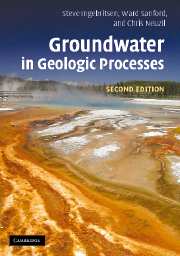Book contents
- Frontmatter
- Contents
- Preface
- Acknowledgements
- List of symbols
- 1 Groundwater flow
- 2 Hydromechanical coupling
- 3 Solute transport
- 4 Heat transport
- 5 Regional-scale flow and transport
- 6 Ore deposits
- 7 Hydrocarbons
- 8 Geothermal processes
- 9 Earthquakes
- 10 Evaporites
- 11 Compaction and diagenesis
- 12 Metamorphism
- 13 Subsea hydrogeology
- References
- Index
6 - Ore deposits
Published online by Cambridge University Press: 12 January 2023
- Frontmatter
- Contents
- Preface
- Acknowledgements
- List of symbols
- 1 Groundwater flow
- 2 Hydromechanical coupling
- 3 Solute transport
- 4 Heat transport
- 5 Regional-scale flow and transport
- 6 Ore deposits
- 7 Hydrocarbons
- 8 Geothermal processes
- 9 Earthquakes
- 10 Evaporites
- 11 Compaction and diagenesis
- 12 Metamorphism
- 13 Subsea hydrogeology
- References
- Index
Summary
Most economically significant ore deposits exist because of the advective transport of solutes and heat by flowing groundwater. Mobilization, transport, and deposition of chemical species are all linked to fluid flow. The thermal effects of flowing groundwater can explain the emplacement of some relatively high-temperature ore deposits at anomalously shallow depths. Although many ore deposits are associated with magmatic– hydrothermal systems, in this chapter we focus on the important subset of ore deposits formed in sedimentary basins with no associated igneous rocks. In particular, we will emphasize Mississippi Valley type (MVT) lead–zinc deposits, other stratiformbase-metal deposits, and both tabular and unconformity-type uranium deposits. Each type of deposit is economically significant, was apparently controlled by regional patterns of groundwater flow, and has been the subject of “paleohydrologic” reconstructions over the past several decades. They are thus of particular interest to hydrogeologists.We will then consider two examples of economic mineralization caused by essentially in situ diagenetic processes: supergene enrichment of copper porphyry deposits and Colombian emeralds. The specific material in this chapter is complemented by the generalized discussions of chemical and heat transport in Chapters 3 and 4 and, more directly, by the discussion of basin-scale flow and transport in Chapter 5. Ore deposits associated with magmatic–hydrothermal systems are considered briefly in Section 8.8 and in considerable detail elsewhere (e.g., Barnes, 1979, 1997; Sillitoe and Hedenquist, 2003).
Mississippi Valley type deposits
Mississippi Valley type ore deposits (MVTs) are stratabound lead–zinc deposits that are found in porous carbonate rocks or (more rarely) sandstones. Most MVTs occur near basin margins (Figure 6.1) or basement highs in tectonically stable continental interiors. Radiometric dating indicates that they formed mainly during large contractional tectonic events (Leach and others, 2001). The common ore minerals include sphalerite (ZnS), galena (PbS), barite (BaSO4), and fluorite (CaF2). MVTs occur worldwide, but those of the United States midcontinent have historically been the most productive and, considered as a group, comprise the largest known accumulation of lead in the Earth's upper crust. Although the intensity of mining has decreased in recent decades, as recently as the mid 1970s a single ore district in southeast Missouri, the Viburnum Trend (Figure 6.1), accounted for 15% ofworld lead production and 85% of United States production (Vineyard, 1977).
- Type
- Chapter
- Information
- Groundwater in Geologic Processes , pp. 193 - 219Publisher: Cambridge University PressPrint publication year: 2006



